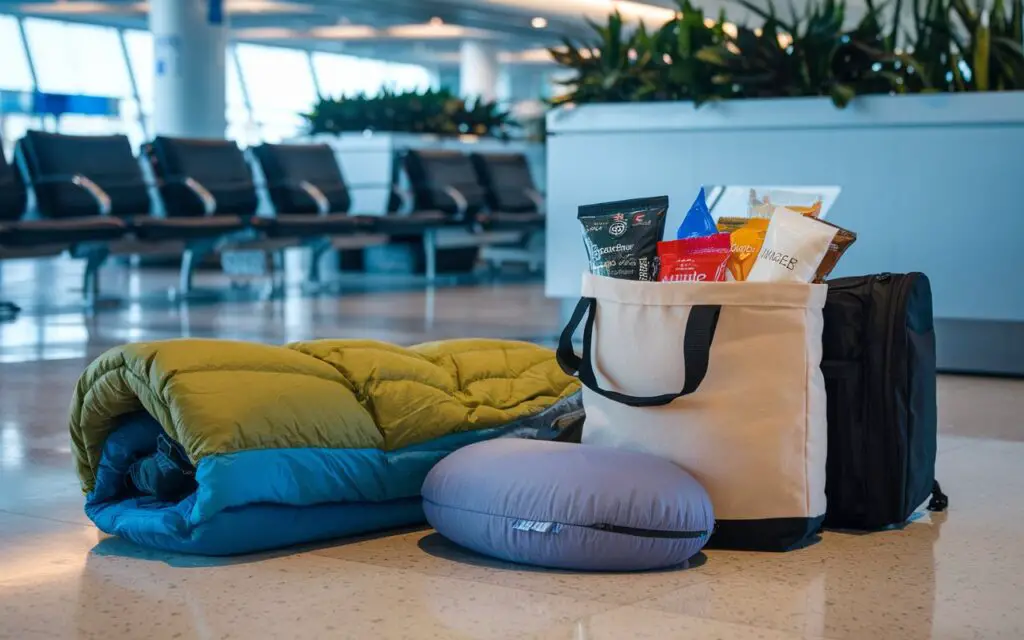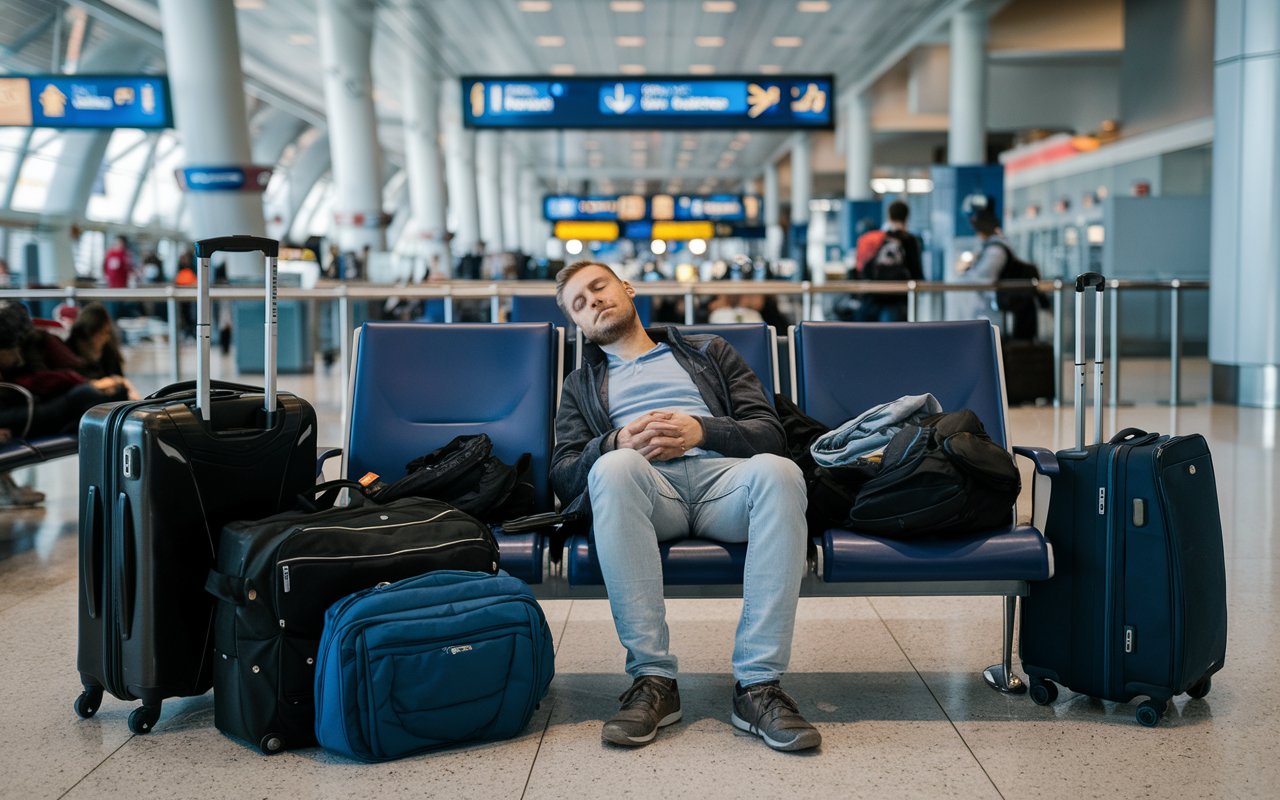Travelers today are increasingly choosing to sleep at airports during long layovers or when dealing with delayed flights. Sleeping at an airport can save both time and money, allowing travelers to avoid hotel expenses and lengthy transportation back and forth from the airport. Moreover, for early morning flights or unforeseen delays, staying within the airport ensures flexibility. While it may not always be the most comfortable option, with the right approach, sleeping at airports can be a surprisingly smart solution for making the most of your layover. However, it does come with its challenges—noise, lighting, and safety—which is why it’s important to be prepared with the right strategies and gear to make your rest as comfortable as possible.
Finding the Perfect Spot to Sleep
When it comes to sleeping at airports, the key to a restful layover is finding the right spot. Not all airport areas are created equal, so doing a bit of research before your trip can make all the difference. Many airports, such as Seattle-Tacoma International Airport (SeaTac), are known for being traveler-friendly, offering quiet zones or rest areas designed specifically for comfort. To locate these spots, look up airport maps or use traveler resources like SleepingInAirports.net, which provides detailed information on the best locations to rest within various airports.
Another essential tip is to avoid high-traffic areas such as near food courts, gates, or restrooms where noise and foot traffic are constant. Instead, look for hidden corners, unused gates, or dedicated rest zones—often marked as “quiet areas”—to ensure a more peaceful environment.
Essential Gear for Sleeping at Airports

Packing the right gear can make the difference between a restless night and a comfortable, refreshing rest at the airport. First and foremost, consider investing in a travel pillow and lightweight blanket. These are essential for staying comfortable, especially if you’re trying to sleep upright in airport chairs. A good neck pillow will provide support, while a small blanket can keep you warm without taking up too much space in your carry-on.
Equally important are eye masks and earplugs. Airports are notoriously bright and noisy, with constant announcements and artificial lighting, even during late hours. An eye mask will help block out unwanted light, and earplugs or noise-cancelling headphones can reduce background noise, making it easier to relax.
Lastly, make sure to dress comfortably and in layered clothing. Airports can be chilly, especially overnight, so having layers ensures you stay warm without having to rely solely on a blanket. Also, wear comfortable shoes that are easy to slip off when resting, but practical for walking through the terminal when needed.
Security and Personal Safety Tips
While sleeping at airports can be convenient, it’s essential to prioritize your personal safety. Start by choosing a safe sleeping location. Ideally, sleep near security desks or in areas with other travelers. These spots are typically well-monitored, reducing the likelihood of theft or disturbances. Additionally, some airports provide designated sleeping areas with enhanced security measures, which are preferable if available.
To keep your belongings safe, use your luggage as a pillow or footrest. This way, if anyone tries to move your bags, you’ll feel it immediately. For smaller, valuable items like passports, wallets, or phones, consider using a money belt or a neck pouch that you can wear while sleeping. It’s also smart to keep one eye open by periodically checking your surroundings, especially if the airport becomes quieter late at night.
Some airports, including Seattle-Tacoma International Airport, offer locker services where you can store larger bags safely. For example, SmarteCarte offers luggage storage with rates based on size and duration, which can help you travel lighter and sleep more soundly without worrying about your bags.
Airport Lounges: A Premium Sleeping Experience
For those willing to spend a little extra, airport lounges can provide a much more comfortable sleeping experience compared to regular seating areas. Many major airports, including Seattle-Tacoma International Airport, offer paid lounges that are open to all travelers, regardless of airline or class of service. Lounges like The Club at SEA provide a quiet, relaxing environment with comfortable seating, often in the form of reclining chairs or even private sleep pods.
The benefits of lounges go beyond just a comfortable place to rest. Most offer amenities like free Wi-Fi, showers, complimentary food and drinks, and sometimes even business services if you need to get some work done. Access to these lounges can be purchased through services like Priority Pass, or you can buy a one-time entry pass directly at the lounge or online.
For longer layovers or when you need a quick nap, lounges can be a worthwhile investment, offering not just rest but also a chance to recharge in a peaceful setting.
Tips for Handling Noise and Lighting
One of the biggest challenges of sleeping at airports is dealing with constant noise and bright lighting. With announcements, chatter, and travelers moving about at all hours, it’s crucial to have a plan for minimizing disruptions. The best way to handle noise is to bring earplugs or noise-cancelling headphones. These simple tools can block out background noise, such as boarding calls and conversations, giving you a better chance at uninterrupted sleep.
When it comes to lighting, airports are typically bright 24/7, so a good eye mask is essential. Not only will an eye mask block out harsh artificial light, but it will also signal to others that you’re trying to rest, which can reduce disturbances. If you can’t find a dark, quiet corner, some airports (like SeaTac) offer sleep pods or reclining chairs designed specifically for resting, where lighting is often more controlled.
Choosing a spot away from main walkways or near less-frequented gates can also help reduce both noise and light exposure, ensuring a more peaceful rest.
Food, Hydration, and Hygiene Tips
Maintaining your energy and well-being during a long layover goes beyond just finding a place to sleep. It’s essential to stay well-fed, hydrated, and clean to feel refreshed and ready for the next leg of your journey. Most airports have a range of dining options, but not all stay open 24/7. Be sure to grab a meal or snack before the restaurants close, or bring some portable snacks like granola bars, nuts, or fruit, especially for overnight layovers.
Staying hydrated is equally important, but airport prices for bottled water can be high. Instead, pack a refillable water bottle and use the free water stations available in many airports. This is an easy way to stay hydrated without breaking the bank.
For hygiene, many airports, including Seattle-Tacoma International, offer shower facilities in airport lounges or public areas. Taking a quick shower can help you feel more awake and refreshed, especially during a long layover. If showers aren’t available, pack travel-sized toiletries, like wet wipes and deodorant, to freshen up. These small steps can make a big difference in your overall comfort and readiness for your flight.
Final Tips for a Successful Layover Sleep
Making the most of your airport layover requires preparation and flexibility. First and foremost, plan ahead by checking airport amenities in advance. Some airports, such as Seattle-Tacoma International Airport (SeaTac), are more accommodating to overnight travelers, offering sleep-friendly zones and resources like luggage storage and paid lounges.
Be sure to keep an eye on your flight schedule and set alarms on your phone to ensure you wake up with plenty of time to get through security and board your flight. Most importantly, approach your layover with the right mindset. While sleeping at an airport may not always be the most comfortable experience, with the right gear, strategic spot selection, and a bit of creativity, you can turn an inconvenient layover into a restful opportunity to recharge.
Frequently Asked Questions (FAQ)
1. Is it safe to sleep at airports?
Yes, sleeping at airports can be safe if you choose a well-monitored location, such as near security or in designated quiet zones. Always keep your belongings close, use luggage as a pillow or footrest, and store valuables in a money belt or neck pouch for added security.
2. What should I bring for sleeping at an airport?
Essential items include a travel pillow, blanket, eye mask, earplugs or noise-cancelling headphones, and comfortable layered clothing. A refillable water bottle and snacks are also useful to stay hydrated and nourished.
3. Where are the best spots to sleep in an airport?
Look for quiet zones, unused gates, or designated rest areas within the airport. Avoid high-traffic areas like food courts or restrooms, and consider lounges if you’re willing to pay for extra comfort. Some airports offer sleep pods or reclining chairs as well.
4. How do I handle noise and light when sleeping at an airport?
Bring earplugs or noise-canceling headphones to block out airport noise and announcements. An eye mask is essential to reduce the impact of artificial lighting. Finding a less-frequented corner or using an airport’s designated rest zones can also help.
5. Are there shower facilities at airports?
Many airports, including Seattle-Tacoma International (SeaTac), offer shower facilities, typically found in lounges or designated public areas. If showers aren’t available, travel-sized toiletries, like wet wipes and deodorant, can help you freshen up during your layover.





Leave a Reply